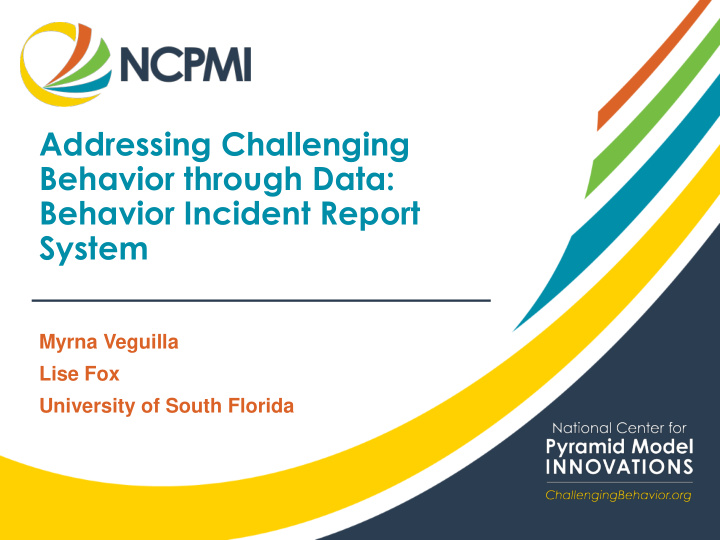



Addressing Challenging Behavior through Data: Behavior Incident Report System Myrna Veguilla Lise Fox University of South Florida
Agenda Introduction to the Behavior Incident Report System BIRS Excel Spreadsheet Questions
Our goal is that all young children and their families can access high quality programs Professionals Children have No incidents work in positive of suspension partnership social, and expulsion with families emotional, and behavioral outcomes
Prevention and Promotion Focus on promotion of social and emotional skills and prevention of challenging behavior. Even when these practices are in place, some young children will engage in challenging behavior.
Young children will experience challenging behavior • It begins early • Between 10-30% of preschool children are not behaviorally and emotionally ready to succeed in school • Early problem behavior is predictive of future challenges • Best predictor of delinquency in adolescence, gang membership, incarceration
Responses to Problem Behavior • Early expulsion or suspension predicts later expulsion or suspension • Rates of expulsion are higher in preschool than in K-12 programs • Data show racial disparities with boys of color experiencing suspension and expulsion disproportionately
Data Decision- Making Leadership Examining Team Implementation and Outcomes Providing Interventions Responding to to Children Staff Buy-In Challenging with Persistent Behavior Challenging Behavior Building Staff Family Capacity Engagement including Coaching
Data that guide decisions related to behavior prevention and response Data for identifying and addressing BIR Analysis concerns related to discipline responses as a Powerful Summary data for challenging behavior across classrooms that provides who, Tool when, where of incidents and how adults respond that might inform program practices Data to identify children and teachers in need of support
What is being measured? • Child incident of behavior that the teacher finds concerning (intensity, frequency, duration) or that exceeds developmentally expected behavior challenges VS • Adult decision that child has violated school social norms (e.g., rule violation) and the nature is a major violation (ODR) or a minor concern that might be handled in the classroom
Behavior Incident Report (BIR) • Form for recording serious behavior incidents and child demographics • Generate graphs that reviewed by the leadership team • Analyze across children, across teachers, individual children, identify potential issues of disproportionality. Goal is to support the child, teacher, and consider actions needed for program improvement
BIR Form • The fields for data collection are a match the behaviors, activities and procedures that occur in ECE
BIRS Training and Instructions
BIR Analytic Elements Measure Analysis Factors Program Behavior incident Type of Problem Classroom frequency Behavior Child Activity Others involved Possible motivation Strategy/Response Administrative follow- up BIR Disproportionality Race/Ethnicity Composition Gender BIR Risk IEP status Risk Ratio DLL
Tracking Administrative Actions: • In-School Suspension • Response: Time in a different classroom or adult outside the classroom • Administrative Follow-Up: Temporary removal from classroom • Out-of-School Suspension • Administrative Follow-up: • Sent home for remainder of day • Sent home for one or more days • Dismissal • Administrative Follow-up: Dismissal from program
BIRS Equity Profile Alerts • Built into the system • Does not require you to manually calculate • Alert displays after data entry Equity Profile Alerts INCIDENT ALERTS Check Race/Ethnicity Equity Profile Check Gender Equity Profile Check DLL Status Profile IN-SCHOOL SUSPENSION ALERTS OUT-of-SCHOOL SUSPENSION ALERTS Check Race/Ethnicity OSS Equity Profile Check Gender OSS Equity Profile Check IEP Status ISS Equity Profile Check DLL Status ISS Equity Profile DISMISSAL ALERTS Check IEP Status Dismissal Equity Profile
Process Teachers Trained - Teachers receive online training on how and when to use a BIR form for a behavior incident Complete BIR Form - Completed by the classroom teacher or staff member following a behavior incident that is not developmentally normative or is a cause for a concern Forms provided to data entry staff - BIR Form is provided to a designated person on staff who enters data into the spreadsheet Data Analysis - The spreadsheet provides a summary for examining factors related to behavior incidents
How to Access
Behavior Incident Report System • BIR Overview Fact Sheet • BIRS Teacher Fact Sheet • BIRS Excel Workbook (Blank and Demo versions) • BIR Form • Instructions for when to complete a BIR with link to teacher training • BIRS Data Decision-Making Guide • BIRS Data Entry Guide
The Tech Stuff • Requires a desktop or laptop computer with: • Windows OS with Microsoft Office 2011 and newer • Mac OS with Microsoft Office 2016 • Office365.com • Plan on where to save your spreadsheet • On your network or other platforms (i.e., Box, DropBox, Google Drive, OneDrive, etc.) This Photo by Unknown Author is licensed under CC BY-ND
BIR Spreadsheet
How do you feel about Excel?
Let’s Take a Look!
Wrapping it up
This Photo by Unknown Author is licensed This Photo by Unknown Author is licensed under under CC BY-SA-NC CC BY-NC-ND
Digging into Data Webinar Series • This webinar series will focus on Pyramid Model data tools • Next webinar: July 14 th @ 3pm EST, “Addressing Challenging Behavior through Data: Implementing the BIRS in Your Program”
Questions
Survey and Certificate Recording Viewers • Type URL shown on recording into a web browser window • URL is case sensitive 29
ChallengingBehavior.org 30
Thank You The contents of this presentation were developed under a grant from the U.S. Department of Education, #H326B170003. However, those contents do not necessarily represent the policy of the U.S. Department of Education, and you should not assume endorsement by the Federal Government. Project officer, Sunyoung Ahn. 31
Recommend
More recommend